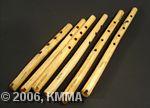


The umwironge is classified as an aerophone and is a flute usually made from the stem of the intomvu plant, although bamboo and a few other types of plant can also be used. The instrument is about 49-75cm long and is made using young stems that have been dried and hollowed out. It tapers slightly from one end to the other. The thin walls make it very fragile so that it often needs to be repaired (or thrown away). A new instrument is often a copy of the old one to ensure that it has the same tone.
To make the mouthpiece, the stem is first cut off straight and a U-shaped notch is then cut out. The umwironge usually has between two and five round finger holes (inoboro), which are always located on the lower part of the instrument.
The umwironge is chiefly played – and was originally exclusively played – by herdsmen to pass the time or to keep any cattle thieves and predators at bay in the evening and at night. It is also played to accompany dances (akagitari and urwagitari) or to entertain an impromptu audience. In the towns the umwironge is often used by night watchmen and invalids who wish to encourage the generosity of passers-by with their music. Originally women were not allowed to play this instrument, but this is now changing to some extent. The umwironge is usually played solo, but it can also be combined with an inanga, an indingiti or with rhythmic instruments.
While recording this flute music we discovered that the music was in fact a story told with a humorous, mocking undertone about relations between the sexes. The upper register (overblowing the flute) mimics the voice of the woman, and the lower register that of the man. Nevertheless, the instrument does also have a symbolic significance, namely the fertility of man, the soil and livestock. In that capacity it is also played in a ritual context during sowing and planting.
The instrument can produce between three and ten notes, depending on the number of finger holes and the overblowing technique used, with the tetrachord and hexachord occurring most often. It is notable that, as is the case with pastoral songs (amahamba), there are no semitones in this scale. The use of the topmost third of the scale is the most important element in creating a melody. The instrument offers scope for improvisation, giving the player complete freedom in rhythmic terms. Swift execution of the melody is the hallmark of the umwirongi, however.
For more information consult the following publications edited by the RMCA:
© KMMA/Jos GANSEMANS